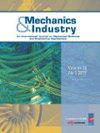Multi-objective optimization of a sports car suspension system using simplified quarter-car models
IF 1.2
4区 工程技术
Q3 ENGINEERING, MECHANICAL
引用次数: 13
Abstract
In this paper, first, the vibrational governing equations for the suspension system of a selected sports car were derived using Lagrange's Equations. Then, numerical solutions of the equations were obtained to find the characteristic roots of the oscillating system, and the natural frequencies, mode shapes, and mass and stiffness matrices were obtained and verified. Next, the responses to unit step and unit impulse inputs were obtained. The paper compares the effects of various values of the damping coefficient and spring stiffness in order to identify which combination causes better suspension system performance. In this regard, we obtained and compared the time histories and the overshoot values of vehicle unsprung and sprung mass velocities, unsprung mass displacement, and suspension travel for various values of suspension stiffness (KS ) and damping (CS ) in a quarter-car model. Results indicate that the impulse imparted to the wheel is not affected by the values of CS and KS . Increasing KS will increase the maximum values of unsprung and sprung mass velocities and displacements, and increasing the value of CS slightly reduces the maximum values. By increasing both KS and CS we will have a smaller maximum suspension travel value. Although lower values of CS provide better ride quality, very low values are not effective. On the other hand, high values of CS and KS result in a stiffer suspension and the suspension will provide better handling and agility; the suspension should be designed with the best combination of design variables and operation parameters to provide optimum vibration performance. Finally, multi-objective optimization has been performed with the approach of choosing the best value for CS and KS and decreasing the maximum accelerations and displacements of unsprung and sprung masses, according to the TOPSIS method. Based on optimization results, the optimum range of KS is between 130 000–170 000, and the most favorable is 150, and 500 is the optimal mode for CS .基于简化四分之一车模型的跑车悬架系统多目标优化
本文首先利用拉格朗日方程推导了某跑车悬架系统的振动控制方程。然后,对方程进行数值求解,得到振动系统的特征根,并对振动系统的固有频率、振型、质量和刚度矩阵进行了验证。其次,得到了对单位阶跃和单位脉冲输入的响应。本文比较了不同阻尼系数和弹簧刚度值对悬架系统性能的影响,以确定哪种组合能使悬架系统性能更好。为此,我们获得了四分之一车模型中不同悬架刚度(KS)和阻尼(CS)值下的车辆非簧载和簧载质量速度、非簧载质量位移和悬架行程的时程和超调值,并进行了比较。结果表明,传递给车轮的冲量不受CS和KS值的影响。增加KS会增加非簧载和簧载质量速度和位移的最大值,增加CS值会略微降低最大值。通过增加KS和CS,我们将有更小的最大悬架行程值。虽然较低的CS值提供更好的乘坐质量,但很低的值是无效的。另一方面,高值的CS和KS导致更硬的悬架,悬架将提供更好的操控性和敏捷性;悬架的设计应结合设计变量和运行参数,使悬架具有最佳的振动性能。最后,根据TOPSIS方法选取CS和KS的最佳值,减小非簧载质量和簧载质量的最大加速度和位移,进行多目标优化。根据优化结果,KS的最优范围在13万~ 17万之间,最有利的是150,而500是CS的最优模式。
本文章由计算机程序翻译,如有差异,请以英文原文为准。
求助全文
约1分钟内获得全文
求助全文
来源期刊

Mechanics & Industry
ENGINEERING, MECHANICAL-MECHANICS
CiteScore
2.80
自引率
0.00%
发文量
25
审稿时长
>12 weeks
期刊介绍:
An International Journal on Mechanical Sciences and Engineering Applications
With papers from industry, Research and Development departments and academic institutions, this journal acts as an interface between research and industry, coordinating and disseminating scientific and technical mechanical research in relation to industrial activities.
Targeted readers are technicians, engineers, executives, researchers, and teachers who are working in industrial companies as managers or in Research and Development departments, technical centres, laboratories, universities, technical and engineering schools. The journal is an AFM (Association Française de Mécanique) publication.
 求助内容:
求助内容: 应助结果提醒方式:
应助结果提醒方式:


